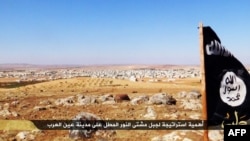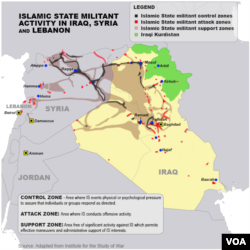Once bent on advancing at all costs to establish its self-declared caliphate, the terror group known as the Islamic State has increasingly been willing to cede territory in battles with Kurdish forces and Iranian-backed Shi’ite militias, raising questions about how and where it would draw its line in the sand.
On the surface, IS appears to be losing momentum. U.S. defense officials say its recent losses in northern Syria — specifically in Tal Abyad, a key hub for foreign fighters and supplies — were a serious blow.
One defense official went so far as to call reports about Islamic State fighters fleeing from Ayn Issa, 50 kilometers from the group’s de-facto capital of Raqqa, an example of the group “breaking under pressure.”
“ISIL’s setbacks in northern Syria are notable and show that it is vulnerable, especially to motivated and well-equipped forces,” a U.S. intelligence official told VOA, using an acronym for the group.
New pragmatism
Yet there is also a sense that, even as the Islamic State’s forces appear to be on the run, the group is operating with a new pragmatism or sophistication that ultimately could make it even more difficult to defeat.
The intelligence official cautioned some setbacks for the Islamic State could be attributed to commanders deciding to cut their losses and fight another day, and warned against confusing the appearance of vulnerability with definite weakness.
Such a disciplined battlefield strategy would represent a significant change from earlier this year, when U.S. military officials estimate the Islamic State lost more than 1,000 fighters to airstrikes alone in a failed attempted to hold the Syrian border town of Kobani.
“In the past their strategy tended to be [that] they wouldn’t retreat, only advance. That’s why they poured way more resources into taking Kobani than was wise,” said Daveed Gartenstein-Ross, a senior fellow at the Foundation for Defense of Democracies. “It seems like they’re doing less of that. They’re doing less of refusing to cede an inch.”
The reasons for the change are not clear. Some analysts attribute it to a shift in leadership, with second-in-command Abu Alaa al-Afri having more sway following reports airstrikes injured or incapacitated Islamic State leader Abu Bakr al-Baghdadi. Others say it is simply more evidence of the Islamic State’s ability to learn and adapt.
Either way, Gartenstein-Ross believes the shift in battlefield doctrine should not be ignored.
“They may be fighting more effectively as an organization from a strategic perspective,” he said.
High-profile losses
Analysts say even Islamic State’s recent high-profile losses in northern Syria need to be put in perspective.
“What [the Islamic State] is recognizing is, in the short term, it’s not going to be able to go as far as it wants as fast as it wants,” said Christopher Harmer, a former U.S. Navy commander, now a senior naval analyst at the Institute for the Study of War. “They’ve traded territory for time and space, and what that means is by shortening their defensive lines, by reducing some of the territory that they hold, they make it easier to defend the rest of that territory.”
U.S. military officials and observers on the ground add there are plenty of signs the Islamic State is prepared to dig in.
Military officials say the Islamic State has long been building defensive fortifications in Raqqa and other key cities, like Mosul and Fallujah, while also laying out improvised explosive devices (IEDs) and booby traps, and even sending in reinforcements.
“They’ve been able to continue to recruit at the rate we kill them,” a senior U.S. military official told VOA.
The Britain-based Syrian Observatory for Human Rights said Wednesday its sources witnessed a large Islamic State convoy carrying fighters, arms and ammunition passing through Raqqa on its way north, presumably to fortify positions closer to Ayn Issa, in order to prevent Kurdish and other anti-IS forces from pushing farther south.
The extent to which the Islamic State is prepared to make a last stand in places like Raqqa and Mosul, to live or die with cities seen as vital to the perpetuation of the group’s self-declared caliphate, is unknown.
Harmer says “ISIS absolutely has red lines" — a point of no return, beyond which they will not retreat — "but they’re not the same way we would consider red lines.”
“There are places that they’ve captured that they want to hold, but if the situation demands that they abandon it, they will,” he said. “But they’ll leave behind 500 fighters who will fight to the death.”
It is a tactic the Islamic State has used in places like Tikrit in Iraq. There is some doubt, though, as to whether IS commanders will need to employ the strategy again in Syria, at least in the short term.
Alliance of convenience
While Kurdish fighters and other anti-Islamic State forces in the north have been effective, aided by U.S. and coalition air power, there are significant questions about how much farther they can go.
One senior U.S. military official described the partnership between the Syrian Kurdish forces, elements of the Free Syria Army and a handful of other groups as an “alliance of convenience,” unlikely to hold together for the type of sustained campaign needed to capture Raqqa.
The official also downplayed the impact of some of the fighting near Ayn Issa, categorizing it as "pulsing" on both sides that has failed to result in any dramatic changes.









